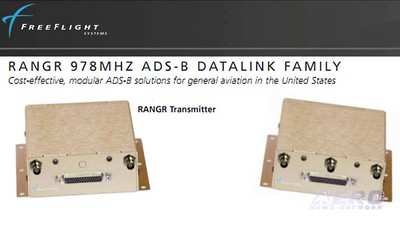Thu, Oct 11, 2012
ADS-B Receiver Combines Performance, Upgradeability With GRT Avionics Advanced Systems For LSA, Experimental Aircraft
FreeFlight Systems announced Thursday that it will integrate its XPLORER ADS-B weather receiver with GRT Avionics Horizon HXr, Horizon HX and Sport SX panel-mounted Electronic Flight Information Systems (EFIS) for experimental and Light Sport aircraft.

Permanently mounted in the aircraft with an external antenna for unimpeded broadcast data reception, the XPLORER ADS-B receiver is based on FreeFlight Systems’ certified RANGR family of 978MHz UAT ADS-B systems (pictured). The XPLORER system receives the full ADS-B datalink broadcast that includes textual and graphical weather. Because the system can be integrated with a certified WAAS GPS and a certified ADS-B Out transmitter, it also can function as a full-featured ADS-B traffic receiver.
While the XPLORER receiver connects to an iPad display via WiFi, it uses a standard wired RS-232 serial port to integrate with the GRT Avionics systems. GRT Avionics’ Horizon HXr, Horizon HX and Sport SX EFIS solutions add advanced avionics capabilities to a wide range of experimental, homebuilt and LSA aircraft. Available in 12.1" and 10.4" size, the Horizon HXr systems seamlessly integrate AHRS, IFR GPS, navigation, communication, transponder, engine monitor, autopilot and audio panel functions in single, dual, or triple-display installations. The 6.5" Horizon HX and Sport SX displays incorporate many of the features of the Horizon HXr in a single compact package.
“GRT Avionics’ products are among the most capable flight displays available for experimental, homebuilt and LSA aircraft,” said Tim Taylor, CEO of FreeFlight Systems. “Because both companies are committed to open technology standards we are able to collaborate to add XPLORER’s weather capabilities and a straightforward and affordable upgrade path to full ADS-B compliance.” “Our customers expect long-term value, high-quality, reliability and the most advanced avionics capabilities in our systems,” said Greg Toman, President of Grand Rapids Technologies. “That’s why the FreeFlight Systems XPLORER ADS-B receiver is an excellent addition to our products and a great way for our customers to add ADS-B functionality.”
More News
A Puff Of Smoke Came Out From The Top Of The Engine Cowling Followed By A Total Loss Of Engine Power On May 9, 2025, about 1020 mountain daylight time, an experimental amateur-buil>[...]
From 2022 (YouTube Edition): Jenny, I’ve Got Your Number... Among the magnificent antique aircraft on display at EAA’s AirVenture 2022 was a 1918 Curtiss Jenny painstak>[...]
Very High Frequency (VHF) The frequency band between 30 and 300 MHz. Portions of this band, 108 to 118 MHz, are used for certain NAVAIDs; 118 to 136 MHz are used for civil air/grou>[...]
“From approximately November 2021 through January 2022, Britton-Harr, acting on behalf of AeroVanti, entered into lease-purchase agreements for five Piaggio-manufactured airc>[...]
Microburst A small downburst with outbursts of damaging winds extending 2.5 miles or less. In spite of its small horizontal scale, an intense microburst could induce wind speeds as>[...]
 NTSB Prelim: Lee Aviation LLC JA30 SuperStol
NTSB Prelim: Lee Aviation LLC JA30 SuperStol Classic Aero-TV: Curtiss Jenny Build Wows AirVenture Crowds
Classic Aero-TV: Curtiss Jenny Build Wows AirVenture Crowds ANN's Daily Aero-Term (05.30.25): Very High Frequency (VHF)
ANN's Daily Aero-Term (05.30.25): Very High Frequency (VHF) Aero-News: Quote of the Day (05.30.25)
Aero-News: Quote of the Day (05.30.25) ANN's Daily Aero-Term (05.31.25): Microburst
ANN's Daily Aero-Term (05.31.25): Microburst



